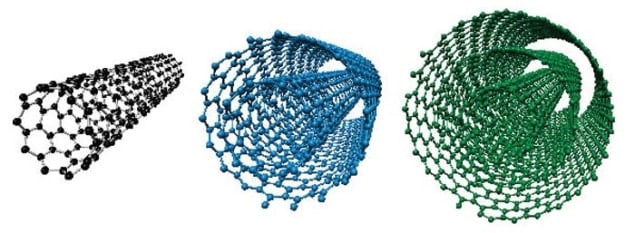
The outer walls of both double- and triple-walled carbon nanotubes (CNTs) protect the innermost tubes from interacting with their environment. That is the key finding of a study by researchers in the US, Germany and Japan, who have made the first detailed examination of triple-walled CNTs using resonant Raman spectroscopy. The protection afforded by the outer layer allows the tiny tubes to be studied in more detail than ever before, which could be a boon to those using CNTs to create new technologies.
A single-walled carbon nanotube (SWCNT) resembles a tiny drinking straw with a wall that is just one carbon atom thick. A double-walled carbon nanotube (DWCNT) consists of two concentric SWCNTs coupled together by weak Van der Waals interactions. The inner and outer tubes can either be semiconducting or metallic. However, because the outer tube is in direct contact with its environment, it can be difficult to obtain accurate information about its fundamental physical properties.
Third wall protects the second
To gain a better understanding of the outer tube in a DWCNT, Thomas Hirschmann and Paulo Araujo at the Massachusetts Institute of Technology and colleagues studied individual and bundled triple-walled carbon nanotubes (TWCNTs). A TWCNT can be thought of as a DWCNT wrapped around a SWCNT. The researchers found that the extra outer tube protects the two inner ones from interacting with their environment, thus allowing them to be studied more accurately. An unrolled TWCNT can be thought of as a trilayer graphene ribbon, and has all the outstanding electronic and mechanical properties that this carbon material boasts.
The team was led by MIT’s Mildred Dresselhaus and included scientists from the University of Hamburg, the Nagaoka University of Technology and Shinshu University. The researchers used a very fast yet sensitive Raman spectrometer, which allowed them to detect and characterize the same individual TWCNT with different laser lines under identical experimental conditions. “Only a few groups in the world are equipped with such an instrument capable of characterizing individual CNTs in this way,” said Hirschmann.
Wall-to-wall measurements
“The analyses allowed us to study fundamental properties such as intertube mechanical coupling, wall-to-wall (WtW) distance, metallicity and curvature-dependent intertube interactions,” he explained. “Such knowledge will be of fundamental importance for technological applications that exploit these nanostructures.”
The researchers characterized five individual TWCNTs in detail and found that the WtW distance between the inner two tubes in all the samples ranges from 0.323 to 0.337 nm. These values are larger than the WtW distance observed in previously studied DWCNTs (0.284–0.323 nm). The distances are also closer to the interlayer distance in graphene (0.335 nm).
“We also found that the intertube interactions affect innermost nanotubes differently, according to which metallicity they have, and that the elusive mechanical coupling between the ‘radial breathing mode’, or RBM, of concentric nanotubes does not exist, even for relatively short WtW distances of 0.323 nm,” added Hirschmann. “This is an important finding and shows that, although the TWCNTs are hybrid systems, the tubes themselves are mostly independent of one another.”
Wealth of information
The RBM is the most important spectroscopic signature of a CNT, the frequency of vibration of which is known to be inversely proportional to the tube diameter, he explained. These so-called first-order Raman features provide a wealth of information on the electronic and vibrational structure of these nanomaterials.
“Our analyses also shed more light on the Van der Waals forces mediating the interactions in concentric ordered CNTs, such as DWCNTs and TWCNTs,” said Araujo. “These low-energy interactions are important for technology applications because they affect the electronic and vibrational properties of the tubes.”
The team is now busy analysing shielding phenomena and intertube interaction effects in multi-walled carbon-nanotube systems. Here, intertube interactions not only affect the measured RBMs but also other Raman features. “One of our main goals is to find better conditions in which to grow CNTs by controlling interactions between nanotubes walls,” said Hirschmann. “To this end, we are working closely with Yoong Ahm Kim and colleagues at Shinshu University, who are experts when it comes to synthesizing these nanomaterials.”
The research is described in ACS Nano.



